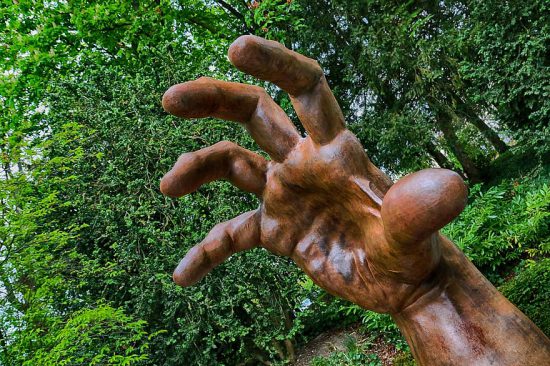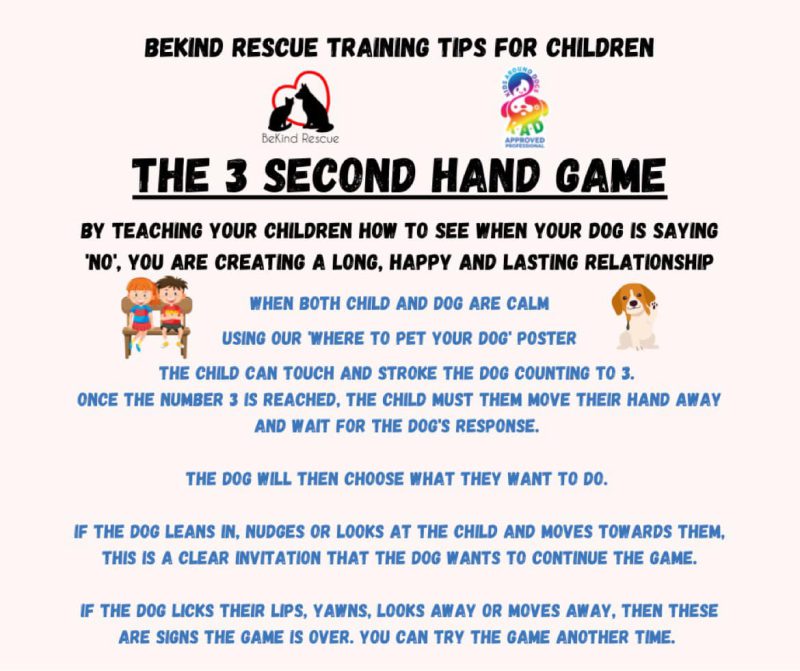Written by Laure-Anne Viselé, zoologist en dog behaviourist
15 Sep 2020
Danny the Yorkshire terrier ‘loves’ kids
This morning, I walking to school with my son and we bumped into Danny-the-Yorkshire-terrier and his human mom. My kid got really excited! Finally I would get to meet the famous Danny, who loves kids so much.
I was curious to see how my kid would handle the encounter – this is a kid whom I have raised into respecting a dog’s choices and spotting their subtle signals. What followed was a bit of a cold shower/parental reality check. Turns out even zoologists’ kids choose to miss a dog’s request for more space when they are hell-bent on petting them.
When Danny-the-Yorkshire saw us, he crouched down low and creeped closer to us, butt wriggling and tail wagging. My kid saw this as confirmation that he wanted to be petted and bent over to pet him on the back (see Pat Pet Pause below for why this is a terrible idea). Danny-the-Yorkshire rolled over on his back and gave off every appeasement signal in the book.
But his tail was wagging!
Sure it was. And do you know what tail wagging means? It means “I have seen you.” It could mean:
- “I have seen you and let’s take it slow.” or
- “I have seen you and I want you dead at the nearest opportunity.” (ever checked a furious guard dog’s tail as he’s chasing you off his property?) or
- indeed “I have seen you. Please pet me.”
Looking at Danny’s non-stop show of over-the-top deference signals, I wasn’t seeing “please pet me” so much as “You’re huge & I am tiny. I can’t go anywhere. You’re bending over me. I want to be petted but I feel overwhelmed. Can we take it down a notch?”
That familiar feeling of sadness crept up in me: how long are we going to keep misunderstanding our dogs? Danny’s pitiful show of deference gave me the same sad feeling I get when a kid acts overly politely and loses all spontaneity when his parents are around. Just how much pressure is Danny-the-Yorkshire under to get petted by every kid in the village?
Are dogs objects to be petted?
I was relieved to see Danny’s human pulling him away (I would have preferred she called him away but yeah, at least he was being taken out of the situation). She was in a rush and he still needed to poop, she explained.
It turns out she too had missed his requests for space. Missed or maybe even dismissed. I am not convinced she would have done much about it even if she’d known he was not 100% comfortable. Most people see their dogs as an object with a function: petting – forced petting if need be.
That sad feeling crept up again: not only do I have to fight against ignorance every day (owners who do not realize the dog is uncomfortable), but how many more dogs are expected to just grin and bear it, regardless of how they feel about it?
This is the sad reality for most dogs, particularly the small and cute ones, whose are on constant petting duty by anyone who feels like touching a dog today: a small, furry, mobile petting zoo.
Why consent matters when petting
The obvious answer is empathy. Why would you force your dog in a situation in which he is not comfortable? That is no fair way to treat a friend and family member.
If empathy does not rock your boat and you see it as your dog’s duty to grin and bear unrequited petting, then perhaps this will be a more compelling reason to look at consent: seeking permission reduces the risk of a dog bite. Drastically so.
So why does seeking consent reduce bite risk? Because our dogs know that, even if they ask nicely, they’ll be heard. This is how the escalation process works with unrequited petting:
- Asking nicely: When they want to get out of a petting situation, most dogs show, like Danny does, appeasement signals. Subtle little body language tells that they are not comfortable. If these polite signals get systematically ignored, some will express their discontent more openly by, say growling.
- Growling: What happens when a dog growls do you think? Most people punish them.
- Biting: With every growl that you punish, you are pushing your dog closer and closer to becoming a silent biter. If asking nicely never works & growling gets you punished, what do you do when you are fresh out of grin-and-bear-it? You bite.
‘But my dog would never bite!’ As a behaviourist, let me tell you: never say never. You should see the countless reports that fly past my desk with: “He bit out of the blue.” and “He had never done anything like it before.” Every dog with a bite history had a first bite. By definition.
Don’t get me wrong. Some dogs, like Danny, seem to be extraordinarily tolerant and to have endless grin-and-bear-it in them. Shouldn’t we actually protect these dogs above all other dogs, from unwanted petting? Aren’t we taking advantage of their good nature?
How do you test for consent when petting a dog? Pat Pet Pause
As far as I remember, I first heard about Pat Pet Pause via the Family Dog’s excellent bite prevention program. Pat Pet Pause is a consent test for dogs. You can use it with not only kids on the street, but your own kids, your guests, passersby, and of course, yourself.
Let me break it down for you:
- Pat: Pat your own leg to invite the dog to close the gap and come closer. Do NOT be the guy who shoves his fist in front of the dog’s face to ‘let them sniff.’ That old wives’ tale cannot die fast enough, as far as I am concerned. If the dog comes closer, then pet. If not, then too bad. He’s not in the mood right now.
- Pet: Pet the dog where they like it. Each dog is different but generally the dog will press the “Yeah! THAT’s the one” spot against your hand. Here’s a couple of tips:
- Scratching their chest (where they can’t reach themselves) and the side of their neck are good bets.
- Avoid bending over the dog, cornering them or facing them straight. That can be a little intense for a dogs. Look and face slightly sideways.
- Pause: After 2-3 seconds of petting, stop and see what the dog does. If the dog stays and asks for more, keep petting for another few seconds, regularly checking. If the dog leaves, then move on. Respect the dog’s choice.
You can see a video of this exercise here.
The 3-seconds hand game
The 3-seconds hand game is another consent test to check whether a dog is actually enjoying being petted at the moment.
The game was created by BeKind Rescue.
I get it now. How can I help?
Spread the word! Share this far and wide!
Further resources
If you need help or have concerns, you are not alone. We are there to help you:
- I have a pup and would like to teach him to feel comfortable with kids/petting. Book a spot in our puppy course (for pups, in The Hague, Netherlands. Book now as spots are limited.)
- I would like to enroll my kid to a kid-dog class to help them see and respect my dog’s boundaries more. Book a spot in our kid-dog course (in Dutch, The Hague, Netherlands, for adult dogs who have previously done an Obedience course)
- My dogs has bitten someone trying to pet him. Make a behaviour advice appointment with our behaviourist. We offer worldwide consults.
Photo credits
- Yorkshire Terrier: Courtesy of Karen Arnold. Downloaded on 15 Sep 2020 from Needpix.com. License: CC0. No modifications made.
- Giant hand: Downloaded on 15 Sep 2020 from Pikist.com. License: Public Domain. No modifications made.
- Spread the word (seagull): Downloaded on 15 Sep 2020 from Pikrepo.com. License: Royalty Free Photos. No modifications made.




